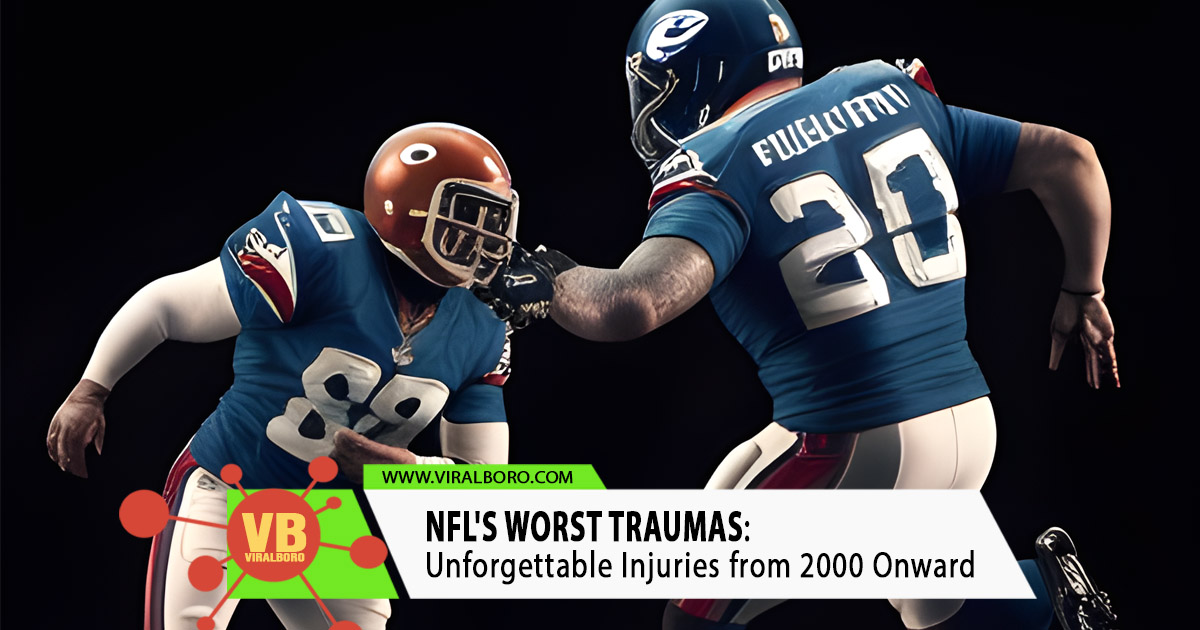NFL's Worst Traumas: Unforgettable Injuries from 2000 Onward
The National Football League (NFL) is a sport that combines incredible athleticism, raw power, and intense competition. However, along with the glory and excitement of the game, NFL players face the risk of sustaining severe injuries that can have long-lasting effects on their careers and lives. In this article, we delve into the worst NFL traumas from the year 2000 onward, examining the devastating injuries that shook the league and left a lasting impact on the players, their teams, and the fans.
1. The Career-Altering Injury: Tom Brady (2008)
When we think of Tom Brady, we usually associate him with unparalleled success, but the NFL legend's path to greatness was nearly derailed in 2008. During the opening game of the season, Brady, then playing for the New England Patriots, suffered a devastating knee injury. The injury, a torn ACL and MCL, required immediate surgery and forced Brady to miss the entire season. This injury not only shook the Patriots organization but also had a significant impact on the NFL landscape, altering the course of Brady's career and potentially changing the trajectory of multiple franchises.
2. The Gruesome Leg Injury: Joe Theismann (1985)
Though the injury occurred in 1985, it remains one of the most chilling and unforgettable moments in NFL history. Joe Theismann, the Washington Redskins' star quarterback, suffered a compound fracture of his leg during a Monday Night Football game against the New York Giants. Theismann's leg snapped gruesomely after a collision with Lawrence Taylor, effectively ending his career. The incident serves as a sobering reminder of the dangers NFL players face on every snap and is etched in the memory of fans and players alike.
3. The Concussion Crisis (2000s-2010s)
Concussions have plagued the NFL for decades, but the 2000s and 2010s brought the issue to the forefront of public consciousness. The league faced mounting criticism for its handling of player concussions and the long-term consequences of these brain injuries. High-profile cases, such as that of former Pittsburgh Steelers linebacker Mike Webster, highlighted the devastating effects of repetitive head trauma. The NFL has since taken steps to address the issue, implementing new protocols and concussion management procedures to protect players' long-term health.
4. The ACL Tear Epidemic (2000s-Present)
In recent years, anterior cruciate ligament (ACL) tears have become increasingly prevalent in the NFL. Numerous star players have fallen victim to this debilitating injury, which often requires extensive rehabilitation and can significantly impact an athlete's performance and career trajectory. Prominent examples include Adrian Peterson, Carson Wentz, and Deshaun Watson, among others. The rise in ACL tears has led to a focus on injury prevention, with teams and medical staff implementing training programs and techniques to reduce the risk of such injuries.
5. The "Deflategate" Controversy (2015)
While not a physical injury, the "Deflategate" scandal involving the New England Patriots and quarterback Tom Brady caused a seismic stir within the NFL. Following the AFC Championship Game in 2015, allegations emerged that the Patriots had intentionally deflated footballs to gain a competitive advantage. The subsequent investigation and subsequent legal battle cast a shadow over the team's accomplishments and Brady's reputation, leaving a lasting stain on one of the league's most successful franchises and its star player.

6. The Paralyzing Injury: Kevin Everett (2007)
In September 2007, the Buffalo Bills' tight end Kevin Everett suffered a catastrophic spinal cord injury during a game against the Denver Broncos. Everett collided with Domenik Hixon while making a tackle, and the impact caused a severe spinal cord compression. Initially, there were concerns that Everett might never walk again, but his determined spirit and extensive rehabilitation led to remarkable progress. While his playing career ended, Everett's incredible recovery became an inspiration to many and raised awareness about spinal cord injuries in football.
7. The Catastrophic Neck Injury: Ryan Shazier (2017)
In December 2017, during a game between the Pittsburgh Steelers and the Cincinnati Bengals, Steelers linebacker Ryan Shazier suffered a devastating spinal injury. Shazier attempted to make a tackle but collided with Bengals receiver Josh Malone, causing him to lose feeling in his lower extremities. The injury required spinal stabilization surgery and left Shazier with a long road to recovery. Despite the immense challenges, Shazier has made remarkable progress and has become an advocate for spinal injury awareness and rehabilitation.
8. The Broken Neck: Peyton Manning (2011)
In 2011, Indianapolis Colts quarterback Peyton Manning experienced a significant neck injury that required multiple surgeries. The injury was a result of a herniated disc and subsequent nerve damage. Manning missed the entire 2011 season and underwent multiple surgeries to correct the issue. While he eventually returned to the field with the Denver Broncos and achieved further success, the injury significantly impacted his career and raised concerns about the long-term effects of neck injuries on NFL players.
The NFL is a sport filled with passion, dedication, and fierce competition, but it also carries inherent risks. The worst traumas from the year 2000 onward serve as stark reminders of the physical toll the game can exact on its players. From career-altering injuries to scandals that shook the league, these traumatic events have left a lasting impact on the players, teams, and fans involved. While strides have been made in improving player safety and preventing injuries, the NFL continues to grapple with the challenges of protecting its athletes while maintaining the essence of the game.

